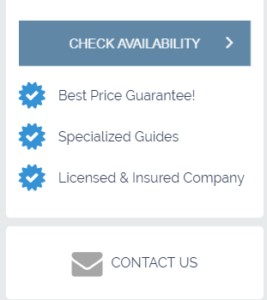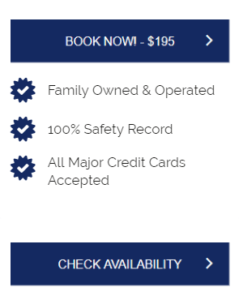According to UNWTO World Tourism Barometer(opens in a new tab), international tourism grew by 7% in 2017 – the biggest growth since 2010 – to reach a substantial 1,322 million arrivals. This is not only fantastic news for the tourism sector but also for the worldwide economy as a whole. It seems there is no stone left unturned when it comes to travel. The question is, as a tour operator, how do you ensure that you win the business of these prospective visitors rather than seeing them go to a close-by competitor?
There are numerous ways for your company to improve sales (including online marketing, engaging in social media(opens in a new tab), offering added value, and so on), but the content on your site goes a long way to attracting potential clients, easing anxieties and establishing value proposition. If you’re struggling to write quality content, don’t sweat: we’ve got you covered! Below are a few tried-and-tested techniques to make your content stand out from the crowd. These are the same techniques that we use when creating your website content and blogs(opens in a new tab).
Generating Ideas
Before you type a single word, you’ll need to do a bit, or a lot (depending on how established your business is), of groundwork. Don’t begin writing until you’ve thought about who you are as a business, where you sit in the market, your customers’ wants and needs, and your current downfalls.
1. Find Your USP. Think about what makes your company tick(opens in a new tab). Perhaps you’ve found yourself in a saturated market and are struggling to find your unique selling point – this requires a bit of research but there is always a way to differentiate yourself. Think about your guides, location, awards, reviews, safety standards, customer service, or the value you bring your clients. There is always something that distinguishes you from the crowd. Find it and highlight it.
2. Listen to Your Customers. If you’re an established business, the enquiries you receive are vital to understanding your tours and your clients. As a general rule of thumb, the fewer enquiries you receive, the more efficient your website is. If you’re finding that enquiries are coming in thick and fast, you could think about including an FAQ section on your tour page to address those questions/concerns before the client even has to click elsewhere. See an example on one of Tourism Tiger’s sites here: Pedal Saloon(opens in a new tab). The easier your site/content is to navigate, the more action the ‘Book Now’ button will get!
3. Do Customer Research. Your branding affects the kinds of clients you attract, of course, but the clients who are booking with you are the real reflection of your company. If you’re an established company, pay attention to demographics, and you’ve got your market. Once a business has a good understanding of who they are targeting, it becomes easier to write content that is appealing and successful in generating sales.
4. Stalk Your Competitors. Keep a close eye on what your competitors are doing. Pay attention to the type of content they are publishing (images, videos, blogs, articles). What kind of tone do they adopt? How do they address their customers? There is an infinite amount you can learn by staying in tune with the marketplace. Recognise that established competitors (and especially high-rankers) have put in all the research and work – study their strategy, and if it’s useful, why not try to implement it yourself?
5. SEO Research. A quick Google search can reveal your main competitors. If they’re high on the list, they must be doing something right! Pay attention to wording in their headlines and tour descriptions. An excellent resource for sourcing keywords is KWfinder(opens in a new tab). Knit these words into your headlines and URLs, but keep wording clear. Additionally, off-site SEO has a huge impact, much more so than optimising headlines and URLS. Our blog post on off-site SEO gives more insight on this.
Writing Content
1. Be Clear. The number one rule for website content. Nobody wants to trudge through large chunks of uninspiring text. The purpose of a tour operator’s website is to convey essential information about the tour/experience. Your prices are what they are for a reason; be proud of them, and let the user find this information fast. From there, they can assess whether your option is a viable one and continue reading your tour page content. Text should be scannable. Break content down into bite-sized sentences; bullet point trip details, bold the important stuff, establish the highlights of the tour and make them the first thing the eye is drawn to.
2. Brand Yourself. Hopefully by now you’ve locked down your business and established a clear agenda. It’s time to spread the message about who you are. Emphasise your brand in your content – WHO you are, WHERE you are located, WHAT you do, WHY you do it, and HOW you do it. Before I book with a tour operator, I want to have a clear understanding of the company and what they offer. Customers need to be convinced of your credibility. Show them you know what you’re doing. Here is an excellent example of a Tourism Tiger website that achieves this: Select South West Tours(opens in a new tab).

3. Speak to Your Target Audience. Are you a luxury tour operator or a budget experience? Your content should appeal to the customers you wish to attract/your current client base. Understand exactly who can benefit from your experience and speak to their wants. Be honest about what to expect – don’t try to woo with frills, just show the value they get from you. View an example of one of our sites which clearly outlines the experience (comfort of the bikes/types of wineries), while marketing towards a more mature, high-end market here: Explore Marlborough(opens in a new tab).
4. Address Fears. This is where customer research comes into use. Use questions you’ve received from prospective clients and address their hesitancies and fears. Establish credibility and reduce anxiety. Adventure companies should emphasise safety records. Long-running companies can mention date of establishment or awards. Smaller tour operators can highlight the fact that they’re family owned.


5. Compare your Tours. It’s not only important to differentiate your company in the market but also to distinguish between the experiences you offer. Each of your tours should have a unique selling point – including key details at the top of each tour page to outline specific experiences is one way to help visitors decide which tour is for them and encourage booking.
6. Emphasise the Experience. Use sensory words. Evoke the sights, sounds and smells your guests will encounter. While you need to include essential details clearly and concisely, don’t be afraid to show visitors a good time and play around with your content. Use descriptions and phrases that reflect your customer. Break up your content with maps, images, and videos to bring your site to life. Use catchy headlines and quirky points of difference. Show them that you offer more than tours, you offer an experience. Revelstoke Reservations(opens in a new tab), a ski company in BC, includes a short promo video, mountain statistics and snow forecasts on its homepage giving you a feel for the slopes before you’ve set foot outside your door!
7. Integrate Videos. Videos are an invaluable resource for any tour operator. One minute of video is worth 1.8 million words, according to Forrester Research’s Dr. James McQuivey(opens in a new tab). As if that wasn’t enough to convince you, an upcoming report from HubSpot Research(opens in a new tab) found that 54% of consumers want to see videos from brands they support in comparison to email newsletters (46%) or social image (41%) based content. Video content was also found to be considerably more memorable than text or images. You can find an example of a video setting expectations on one of Tourism Tiger’s most recent sites here: Wild Rover Tours’ Kilkenny, Wicklow Mountains, Glendalough Day Tour from Dublin(opens in a new tab).
8. Celebrate Your Successes. Reviews, media mentions, partnerships – share your successes with your customers! That’s a lot of happiness not to spread. There is a difference between establishing credibility and bragging – don’t say it yourself, show your visitors (through reputable third parties) the value they get from you.

We have launched so many beautiful sites lately, but here are a few to hopefully inspire and help get you started!
Revelstoke Reservations(opens in a new tab)
Select South West Tours(opens in a new tab)
Sky’s The Limit Ballooning(opens in a new tab)
Maika Tours(opens in a new tab)
So what are you waiting for? Blow potential customers away with your incredible content! Or, if you’re still not convinced that you’re up for it, you can always contact us(opens in a new tab) to get a new site with fresh content!
Find this article useful? Enter your details below to receive your FREE copy of 95 Epic Places To List Your Tours and receive regular updates from Tourism Tiger and leading industry experts.
By submitting this form you agree to Tourism Tiger contacting you via email.